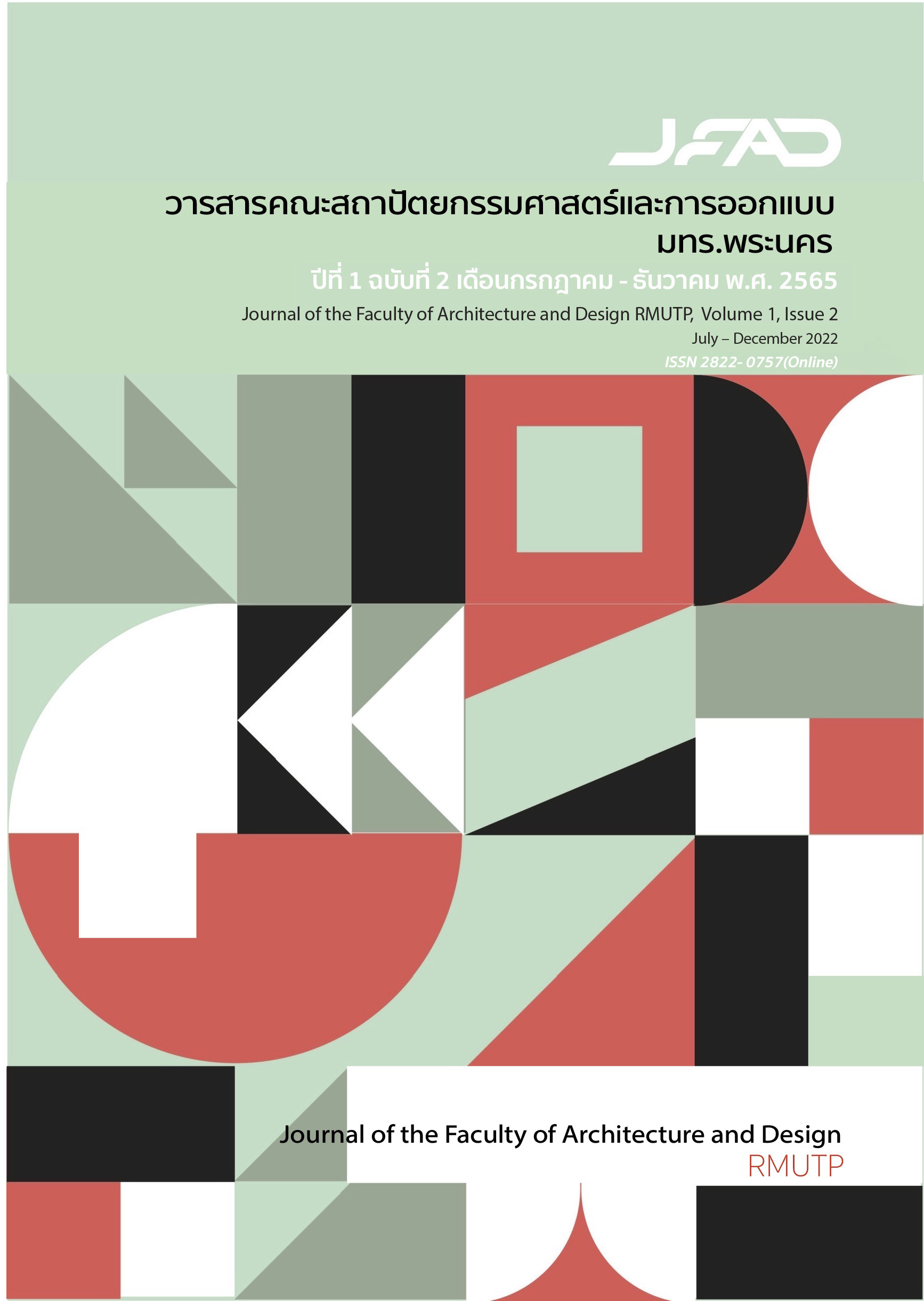การบูรณาการองค์ความรู้: การออกแบบผลิตภัณฑ์อุตสาหกรรมเชิงสร้างสรรค์
Main Article Content
บทคัดย่อ
องค์ความรู้ที่มีความหลากหลายในยุคสมัยปัจจุบันและอนาคตนั้น ถือได้ว่าเป็นเสมือนปัญหาที่ดำรงอยู่ในลักษณะของสิ่งละอันพันละน้อยในประเด็นความรู้ที่เป็นคุณประโยชน์ในการต่อเติมทักษะทางด้านการสร้างสรรค์ผลิตภัณฑ์เชิงอุตสาหกรรมให้เกิดเป็นทักษะทางปัญญาและทักษะทางการปฏิบัติขึ้นภายในตนเองของผู้เรียนทางด้านการออกแบบผลิตภัณฑ์เชิงอุตสาหกรรม ซึ่งบทความวิชาการนี้ถือเป็นเสมือนบทเรียนเสริมที่ช่วยแสดงการบูรณาการในรูปแบบของการนำพาความรู้ที่เป็นปัญญาญาณอันล้ำค่าให้ตัวของนักศึกษาทางด้านการ ออกแบบผลิตภัณฑ์ให้สามารถนำความรู้เหล่านี้ไปประยุกต์ใช้ในการออกแบบผลิตภัณฑ์เชิงอุตสาหกรรมเพื่อการตอบสนองความต้องการของผู้บริโภค หรือการตอบสนองความต้องการของตลาดได้อย่างมีประสิทธิภาพ ซึ่งการออกแบบผลิตภัณฑ์เชิงอุตสาหกรรมเพื่อตอบสนองมนุษย์ในยุคปัจจุบันและยุคอนาคตนั้นถือได้ว่านับวันที่ผันผ่านก็ยิ่งทวีความสลับซับซ้อนมากขึ้นกว่าในกาลอดีตที่ผ่านมา ซึ่งถือเป็นผลกระทบที่เกิดจากความผันผวนของสถานการณ์ที่แวดล้อมตัวของมนุษย์ที่ดำรงอยู่ในช่วงกาลเวลาปัจจุบันและอนาคต ดังนั้นบทความวิชาการฉบับนี้จึงมุ่งหมายสร้างปัญญาญาณที่ช่วยกระตุ้นให้ผู้อ่านสามารถเท่าทันสถานการณ์ที่ประกอบสร้างขึ้นจากองค์ประกอบทางปัญญาด้านการออกแบบผลิตภัณฑ์อันหลากหลายที่ส่งอิทธิพลโดยทางตรงและทางอ้อมต่อกระบวนการออกแบบผลิตภัณฑ์เชิงอุตสาหกรรม และมีขอบเขตแห่งปัญญาญาณอันกว้างขวางที่ช่วยส่งผลลัพธ์ให้ผู้เรียนมีความสามารถหลอมรวมความรู้อันกว้างขวางไปสู่การประยุกต์และการบูรณาการเพื่อใช้งานใน กระบวนการสร้างสรรค์ กระทั่งความรู้และความสามารถที่เป็นทักษะเหล่านี้ ช่วยนำพาผู้อ่านให้มีพื้นฐานของปัญญาญาณและการปฏิบัติเพื่อตอบสนองความต้องการของมนุษย์ได้อย่างสอดคล้องกับสถานการณ์ที่กำลังดำรงอยู่ในช่วงกาลเวลาปัจจุบันและอนาคตข้างหน้าได้อย่างเท่าทัน
Article Details

This work is licensed under a Creative Commons Attribution-NonCommercial-NoDerivatives 4.0 International License.
Copyright (c) 2023 : คณะสถาปัตยกรรมศาสตร์และการออกแบบ มหาวิทยาลัยเทคโนโลยีราชมงคลพระนคร
References
เคน เคย์. (2562). 21st Century Skill. แปลโดย วรพจน์ วงศ์กิจรุ่งเรือง. กรุงเทพฯ: บริษัท บุ๊คสเคป จำกัด.
เจมส์ บาเรนกา และรอน เบรนด์. (2562). ทักษะแห่งอนาคตใหม่ การศึกษาเพื่อศตวรรษที่ 21. แปลโดย วรพจน์ วงษ์กิจรุ่งเรือง. กรุงเทพฯ: สำนักพิมพ์บุ๊คสเคป.
อดัม แกรนต์. (2558). ออริจินอลส์ เพราะความเหมือนไม่เคยเปลี่ยนโลก. แปลโดย วิโรจน์ ภัทรทีปกร. กรุงเทพฯ: สำนักพิมพ์วีเลิร์น.
Børte, K., Nesje, K. & Lillejord, S. (2020). Barriers to student active learning in higher education, Teaching in Higher Education https://doi.org/10.1080/13562517.2020.1839746
Barnabè, F. & Nazir, S. (2022). Conceptualizing and enabling circular economy through integrated thinking. Corporate Social Responsibility and Environmental Management, 29(2), 448-468. https://doi.org/10.1002/csr.2211
Busco, C., Granà, F., & Quattrone, P. (2017). Integrated Thinking. CIMA Research Executive Summary, 13(3), Chartered Institute of Management Accountants.
Egan, A., Maguire. R., Christophers, L. & Rooney, B. (2017). Developing creativity in higher education for 21st century learners: A protocol for a scoping review. International Journal of Educational Research, 82, 21-27. https://doi.org/10.1016/j.ijer.2016.12.004
Giacomazzi, M., Fontana, M. & Trujillo, C. C. (2022). Contextualization of critical thinking in sub-Saharan Africa: A systematic integrative review. Thinking Skills and Creativity, 43, 100978. https://doi.org/10.1016/j.tsc.2021.100978
González-Pérez, L. I. & Ramírez-Montoya, M. S. (2022). Components of Education 4.0 in 21st Century Skills Frameworks: Systematic Review, Sustainability, 14(1): 1493.
Grossmann, I. (2017). Wisdom in Context. Perspectives on Psychological Science, 12(2), 233–257. https://doi.org/10.1177/1745691616672066
Hamzah, H., Hamzah, M. I. & Zulkifli, H. (2022). Systematic Literature Review on the Elements of Metacognition-Based Higher Order Thinking Skills (HOTS) Teaching and Learning Modules. Sustainability, 14(2), 813, https://doi.org/10.3390/su14020813
Hargreaves, M. B. & Podems, D. (2012). Advancing Systems Thinking in Evaluation: A Review of Four Publications. American Journal of Evaluation, 33(3), 462–470. https://doi.org/10.1177/1098214011435409
Hartikainen. S., Rintala, H., Pylväs, L. & Nokelainen, P. (2019). The Concept of Active Learning and the Measurement of Learning Outcomes: A Review of Research in Engineering Higher Education. Education Sciences, 9(4), 276 https://doi.org/10.3390/educsci9040276
Kallio, E. (2011). Integrative thinking is the key: An evaluation of current research into the development of adult thinking. Theory & Psychology, 21(6), 785–801. https://doi.org/10.1177/0959354310388344
Koh, J. H. L., Chai, C. S., Wong, B. & Hong, H. Y. (2015). Design Thinking and 21st Century Skills. In: Design Thinking for Education. Singapore: Springer.
Livingston, L. (2010). Teaching Creativity in Higher Education. Arts Education Policy Review, 111(2), 59-62, https://doi.org/10.1080/10632910903455884
Maslow, A. (1970). Human needs theory: Maslow’s hierarchy of human needs. In R.F. Craven & C. J. Hirnle (Eds.), Fundamental of Nursing: Human Health and Function. Philadelphia: Lippincott.
Maslow, A. (1970). Motivation and Personality. New York: Harpers and Row.
Miller, A. L. & Dumford, A. D. (2016). Creative Cognitive Processes in Higher Education. The Journal of Creative Behavior, 50(4), 282-293. https://doi.org/10.1002/jocb.77
Oliver, J., Vesty, G. & Brooks, A. (2016). Conceptualising integrated thinking in practice. Managerial Auditing Journal, 31(2), 228-248. https://doi.org/10.1108/MAJ-10-2015-1253
Petrova, E. (2017). The influence of positive reinforcements on motivation for education and training activities. Journal of Economic Development, Environment and People, 6(3), 6-15. https://doi.org/10.26458/jedep.v6i3.548
Ramírez-Montoya, M. S., Castillo-Martínez, I. M., Sanabria-Z. J. & Miranda, J. (2022). Complex Thinking in the Framework of Education 4.0 and Open Innovation-A Systematic Literature Review. Journal of Open Innovation: Technology, Market, and Complexity, 8(1), 4. https://doi.org/10.3390/joitmc8010004
Reaves, J. (2019). 21st-century skills and the fourth industrial revolution: a critical future role for online education. International Journal on Innovations in Online Education, 3(1): 91-99.
Sahin, M. C. (2009). Instructional design principles for 21st century learning skills. Procedia - Social and Behavioral Sciences, 1(1): 1464-1468.
Sill, D. J. (1996). Integrative Thinking, Synthesis, and Creativity in Interdisciplinary Studies. The Journal of General Education, 45(2), 129-151. https://www.jstor.org/stable/27797296
Stephen R. G. (2015). Wisdom. Australasian Journal of Philosophy, 93(1), 139-154. https://doi.org/10.1080/00048402.2014.937449
Sternberg, R. J. (1998). A Balance Theory of Wisdom. Review of General Psychology, 2(4), 347–365. https://doi.org/10.1037/1089-2680.2.4.347
Summerville, J. & Reid-Griffin, A. (2008). Technology integration and instructional design. TechTrends, 52(5): 45–51.
Ward, L. & Parr, J. M. (2010). Revisiting and reframing use: Implications for the integration of ICT. Computers & Education, 54(1): 113–122.
Wilterson, A. I. & Graziano, M. S. A. (2021). The attention schema theory in a neural networkagent: Controlling visuospatial attention using adescriptive model of attention. PNAS, 118(33), e2102421118. https://doi.org/10.1073/pnas.2102421118

